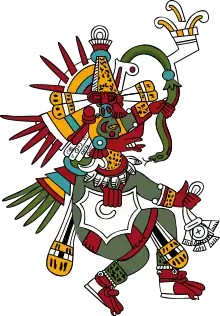The Codices Azoyú I & II are two Mesoamerican pictorial codices, painted in Tlapa around 1565. They were accidentally discovered in 1940 in the town of Azoyú, after which they are named. Both codices depict and offer supporting evidence for the Mesoamerican belief of nahualism.
Content
Codex Azoyú I
The larger of the two codices, where the most powerful ruler of the Tlachinollan Kingdom in Guerrero is depicted as a jaguar devouring a man and transforming into a god.[1] The ruler, Quiyahuital Tecuhtli, satisfied conditions as a nahual, being a noble and born on the first day of the "Rain" calendar.[2] Two regions of the Tlachniollan Kingdom were Tlapa and Tlachniollan until 1421 when a single ruler, likely being the god depicted, combined them into the one kingdom. This codex along with Codex Azoyú II and supplemental pictorial manuscripts known as the Humboldt Fragment 1 and the Lienzo de Tlapa show the reign of Lord Rain during approximately 1421 to 1564, and are thought to have been created for resolving issues of royal succession.[3]
Codex Azoyú II
A compliment to Codex Azoyú I, pictures depict the jaguar sacrificing a man. Along with the other manuscripts mentioned above, a broader history of present-day Guerrero is depicted through the Tlapa-Tlachniollan development under the Rain God and eventual Spanish conquest.
Material Analysis
Present day material analysis conducted on the two codices supports the timeline depicted in the manuscripts. Researchers in archaeological science detected gypsum and indigo fluorescence that corresponds with the types of dyes used in Mesoamerica, yet later portions of the codices also contained inorganic pigments commonly used in Europe during the second half of the sixteenth century.[4] These results are consistent with the idea that native Mesoamerican methods and European methods of dye creation and history recording were prevalent during the period of the codices birth. It is likely that Mesoamerican traditions in Tlapa-Tlachniollan existed during and succeeding Spanish conquest.
References
- ↑ Vega Sosa, Constanza (1996). Codice Azoyu 1: El Reino De Tlachinollan (Codices Mexicanos) (Pt. 1) (Spanish ed.). Univ of Oklahoma Pr; Bk&Acces edition. ISBN 978-0806199382.
- ↑ Guernsey, Julia; Clark, John E.; Arroyo, Bárbara (2010). The Place of Stone Monuments: Context, Use, and Meaning in Mesoamerica's Preclassic Transition. Harvard University Press. p. 47. ISBN 978-0884023647.
- ↑ Oudijk, Michel R. (2012). Codice Azoyú 2: El señorío de Tlapa-Tlachinollan. 2 vols. Mexico: Fondo de Cultura Econ ómica, Instituto Nacional de Antropología e Historia.
- ↑ Zetina, S.; Ruvalcaba, J.L. (Summer 2008). "Non Destructive In Situ Study of Mexican Codices: Methodology and First Results of Material Analysis for the Colombino and Azoyu Codices". International Symposium on Archaeometry: 349–354. doi:10.1007/978-3-642-14678-7_50. ISBN 978-3-642-14677-0.
